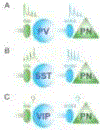Inhibitory Interneurons Regulate Temporal Precision and Correlations in Cortical Circuits
- PMID: 30274604
- PMCID: PMC6173199
- DOI: 10.1016/j.tins.2018.07.015
Inhibitory Interneurons Regulate Temporal Precision and Correlations in Cortical Circuits
Abstract
GABAergic interneurons, which are highly diverse, have long been thought to contribute to the timing of neural activity as well as to the generation and shaping of brain rhythms. GABAergic activity is crucial not only for entrainment of oscillatory activity across a neural population, but also for precise regulation of the timing of action potentials and the suppression of slow-timescale correlations. The diversity of inhibition provides the potential for flexible regulation of patterned activity, but also poses a challenge to identifying the elements of excitatory-inhibitory interactions underlying network engagement. This review highlights the key roles of inhibitory interneurons in spike correlations and brain rhythms, describes several scales on which GABAergic inhibition regulates timing in neural networks, and identifies potential consequences of inhibitory dysfunction.
Keywords: VIP; interneuron; oscillation; parvalbumin; somatostatin; synchrony.
Copyright © 2018 Elsevier Ltd. All rights reserved.
Figures



References
-
- Csicsvari J et al. (1998) Reliability and state dependence of pyramidal cell-interneuron synapses in the hippocampus: an ensemble approach in the behaving rat. Neuron 21 (1), 179–89. - PubMed
Publication types
MeSH terms
Grants and funding
LinkOut - more resources
Full Text Sources

